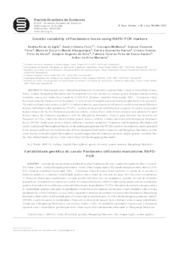Genetic variability of Pantaneiro horse using RAPD-PCR markers.
Genetic variability of Pantaneiro horse using RAPD-PCR markers.
Autoria: EGITO, A. A. do; FUCK, B. H.; MCMANUS, C.; PAIVA, S. R.; ALBUQUERQUE, M. do S. M.; SANTOS, S. A.; ABREU, U. G. P. de; SILVA, J. A. da; SERENO, F. T. P. de S.; MARIANTE, A. da S.
Resumo: Blood samples were collected from Pantaneiro Horses in five regions of Mato Grosso do Sul and Mato Grosso States. Arabian, Mangalarga Marchador and Thoroughbred were also included to estimate genetic distances and the existing variability among and within these breeds by RAPD-PCR (Random Amplified Polymorphic DNA - Polymerase Chain Reaction) molecular markers. From 146 primers, 13 were chosen for amplification and 44 polymorphic ands were generated. The analysis of molecular variance (A M O V A) indicated that the greatest portion of detected variability was due to differences between individuals within populations (75,47%). analysis of the genetic variability among pairs of population presented higher estimates for the five Pantaneiro populations with the Arabian breed, while lowest estimates were presented by pairs formed among the Pantaneiro populations with the Mangalarga Marchador . Highest genic diversity was shown by the Pantaneiro (0.3396), which also showed highest distance with the Arabian and lowest with Mangalarga Marchador breed. UPGMA dendrogram showed distinet differences between naturalized (Pantaneiro and Mangalarga Marchador) and exotic (Arabian and Thoroughbred) breeds. In the dendrogram generated by UPMGA method, the similarity matrix generated by the Jaccard coefficient showed distinction between the naturalised breeds, Pantaneiro and Mangalarga Marchador, and the exotic breeds, Árab and English Thoroughbred. Results suggest that the Pantaneiro presents a higher genetic variability than the other studied breeds and has a close relationship with the Mangalarga Marchador.
Ano de publicação: 2007
Tipo de publicação: Separatas
Unidade: Embrapa Pantanal
Observações
1 - Por padrão são exibidas publicações dos últimos 20 anos. Para encontrar publicações mais antigas, configure o filtro ano de publicação, colocando o ano a partir do qual você deseja encontrar publicações. O filtro está na coluna da esquerda na busca acima.
2 - Para ler algumas publicações da Embrapa (apenas as que estão em formato ePub), é necessário ter, no celular ou computador, um desses softwares gratuitos. Sistemas Android: Google Play Livros; IOS: iBooks; Windows e Linux: software Calibre.
Acesse outras publicações
Acesse a Base de Dados da Pesquisa Agropecuária (BDPA) para consultar o acervo completo das bibliotecas da Embrapa.

